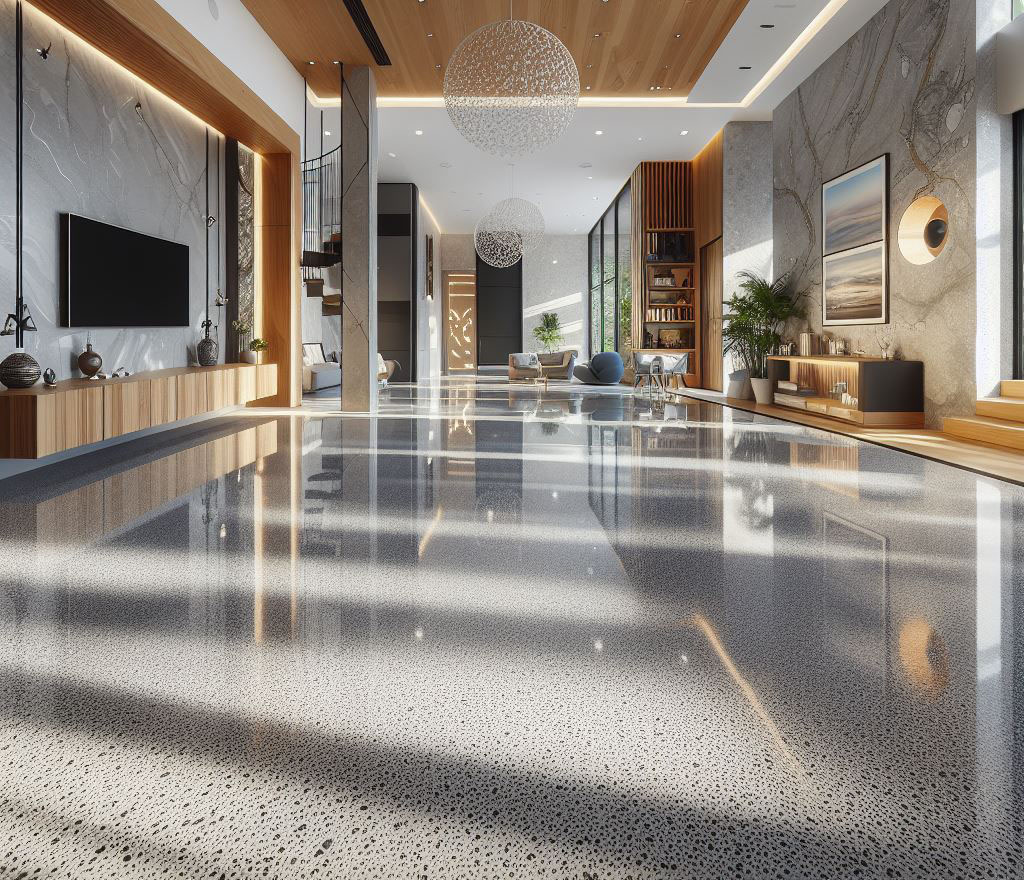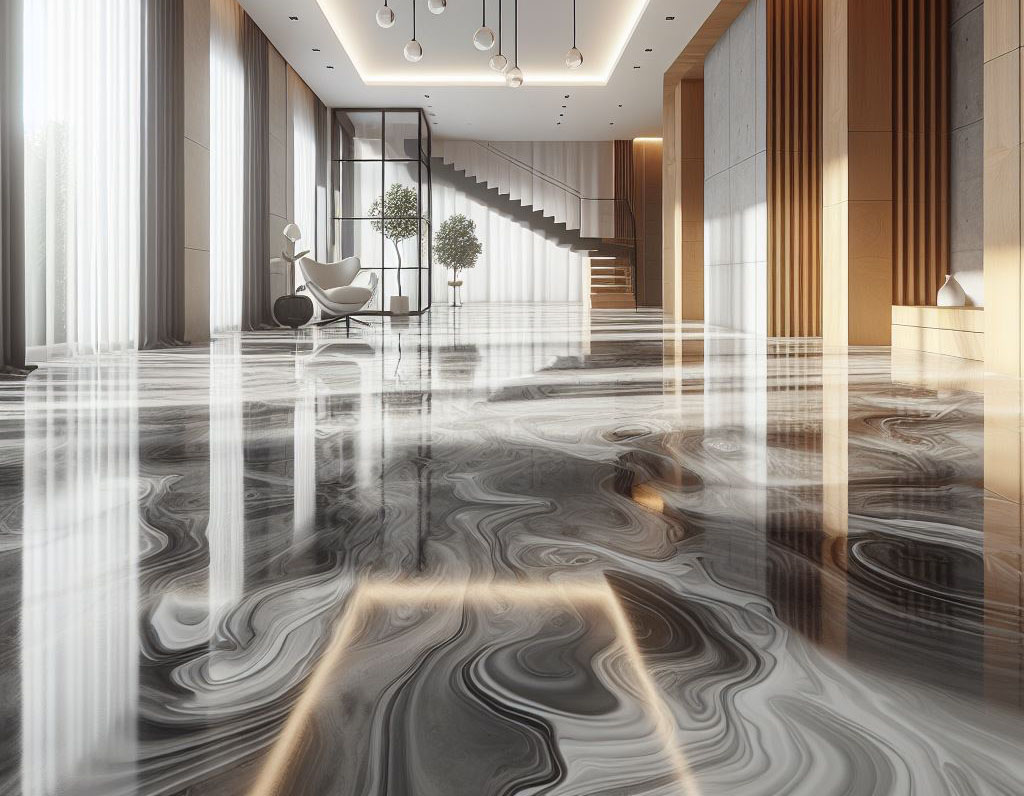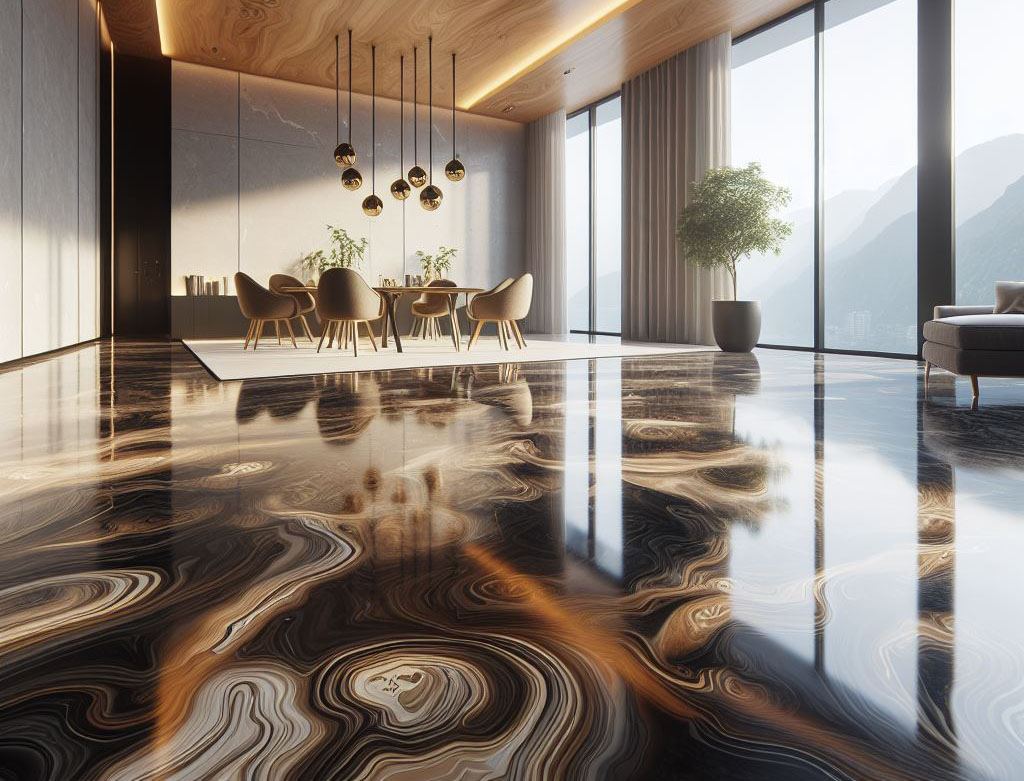In the world of home construction and renovation, few things have made as significant an impact as epoxy flooring. Its surge in popularity is no surprise to those in the know. These floors offer not just a practical solution but also bring an aesthetic edge to both home and commercial spaces.
Epoxy flooring is akin to laying down a protective and decorative shield over your existing floor. It’s a blend of resins and hardeners that, when combined, form a robust, long-lasting surface. This isn’t just a coating, it’s a transformation, turning ordinary concrete into a masterpiece of durability and design.

The Basics of Epoxy Floors
Definition and Composition: At its core, epoxy flooring is a result of a chemical reaction. When you mix a liquid resin with a hardening agent, it cures into a rigid, plastic-like surface. This cured floor is not only hard but also resistant to degradation, making it ideal for heavy-duty environments.
Types of Epoxy Flooring: Variety is the spice of life, and epoxy floors offer plenty:
- Self-Leveling Epoxy: Perfect for creating a smooth, seamless surface over old, cracked, or uneven concrete.
- Graveled Epoxy: This type adds a decorative flair, allowing for unique patterns or brand logos to be embedded in the floor.
- Terrazzo Epoxy: A luxurious option, terrazzo epoxy is ideal for commercial spaces, offering both durability and elegance.
- And More: From flake epoxy that provides subtle texture to anti-static variants ideal for specific industrial settings, there’s an epoxy solution for almost every need.

Advantages of Choosing Epoxy Flooring
- Durability and Longevity: Epoxy floors are built to last. They resist wear and tear from heavy foot traffic, impacts, stains, and moisture. This makes them an excellent choice for garages, basements, commercial kitchens, and more.
- Aesthetic Appeal: The range of finishes and styles available in epoxy flooring is vast. You can opt for solid colors, metallic finishes, or even custom designs. The choice is yours, allowing for complete creative control.
- Ease of Maintenance: Epoxy floors are incredibly easy to maintain. Regular sweeping and occasional mopping with mild soap are all it takes to keep these floors looking pristine.
- Health and Safety Benefits: These floors are not only about looks and longevity. They offer practical benefits, too. Their non-slip surface reduces the risk of slips and falls, and their resistance to mold, mildew, and bacteria promotes a healthier environment.
Installation Process
Surface Preparation: The foundation of a successful epoxy flooring project lies in meticulous surface preparation. It’s akin to laying the groundwork for a sturdy building. Start by thoroughly cleaning the concrete surface, it should be free of oils, grease, and dust. Next, the concrete needs to be roughened up—think of it as creating a canvas for your epoxy to adhere to. Acid etching or mechanical grinding are your go-to methods here, akin to a skilled carpenter ensuring a surface is level before proceeding.
Application Techniques: Mixing and applying epoxy is a precise affair. It’s reminiscent of a chef carefully measuring ingredients for a perfect dish. After mixing the resin and hardener, you have a limited working time. Use a nap roller for an even application, ensuring no area is left uncoated. This step requires a steady hand and a keen eye, much like a master painter ensuring every stroke is perfect.
Curing Time and Tips: Epoxy flooring is not a rush job. The curing process is crucial and can be likened to letting wood properly season before use. Generally, you’ll need to wait about 24 to 72 hours for foot traffic and up to a week for heavy loads. The ambient temperature and humidity play crucial roles in this process—too much or too little of either can affect the outcome, much like the environmental considerations in other construction processes.

Cost Analysis
- Cost Comparison: Epoxy flooring, at first glance, may seem more expensive than other flooring options like vinyl or carpet. However, consider its longevity and durability—it’s an investment that pays off in the long run, much like quality roofing materials or energy-efficient windows.
- Factors Influencing Cost: The cost of epoxy flooring is influenced by several factors. The size of the area being covered is paramount, much like estimating paint for a house. The type of epoxy used also affects the cost, as does labor if you’re not applying it yourself. It’s a balance of material costs and craftsmanship.
- Long-term Savings: The durability and low maintenance of epoxy flooring lead to long-term savings. It’s resistant to damage and easy to clean, making it a cost-effective choice in the long run, much like investing in quality insulation or high-grade lumber.
Customization and Design Options
Color and Pattern Choices: The versatility of epoxy in terms of color and pattern choices is remarkable. From solid colors to intricate patterns, the options are as varied as the choices in wall paint or tile designs. This flexibility allows for personalization of space, akin to custom cabinetry or bespoke fixtures.
Creative Applications: Epoxy flooring isn’t limited to garages or industrial spaces. Its use in residential kitchens, bathrooms, and even in commercial settings like retail stores or restaurants, is a testament to its versatility. It’s comparable to the adaptability of hardwood or tile in various architectural designs.
Common Challenges and Solutions
Moisture Issues: Like wood that warps with moisture, epoxy flooring can fail if the concrete substrate has moisture issues. Conducting a moisture test before application is as crucial as checking for load-bearing walls before a renovation.
Bubbles and Imperfections: The appearance of bubbles or imperfections during application can be likened to the challenges faced when applying a smooth plaster finish. These can be addressed by using a spike roller to remove bubbles and sanding down imperfections, followed by a topcoat application, much like sanding and refinishing a hardwood floor to achieve a flawless finish.

DIY vs. Professional Installation
- When to DIY: Embarking on a DIY epoxy flooring project is akin to tackling a complex woodworking project. It’s suitable for those who have dabbled in hands-on home improvements. If you’re contemplating a smaller area, like your home workshop or basement, and have a good grasp of meticulous surface preparation and precise application, DIY could be a rewarding challenge. It’s essential to be methodical and patient, just as you would be when setting tiles or hanging drywall.
- Hiring a Professional: For larger or more complex projects, such as a full house or commercial space, it’s prudent to hire a professional. This decision is comparable to enlisting a master plumber for intricate plumbing work. Professional installers bring not only their expertise but also specialized equipment. They can efficiently handle unexpected issues, ensuring a flawless finish. This choice often leads to a more durable and aesthetically pleasing outcome.
Maintenance and Repair
- Regular Maintenance: Maintaining an epoxy floor is straightforward and requires only simple tools and techniques. Regularly sweep the floor to remove debris, akin to brushing sawdust off your workbench. For mopping, use a gentle detergent – the approach is similar to caring for a polished wood surface. This routine upkeep helps preserve the floor’s sheen and longevity.
- Dealing with Damage: Addressing scratches or cracks in epoxy flooring can be likened to repairing minor nicks in a hardwood floor. For scratches, lightly sand the affected area and apply a new topcoat. For cracks, clean the area thoroughly, fill it with an epoxy-based filler, and apply a topcoat. These steps are akin to patching and refinishing wood, requiring attention to detail and careful application.
Environmental Impact
Eco-Friendliness: Epoxy flooring is a more environmentally friendly option in the long term. Its durability reduces the frequency of replacements – much like high-quality, energy-efficient windows that don’t need frequent replacement. Moreover, modern epoxy formulations have lower levels of volatile organic compounds (VOCs), making them safer and more eco-friendly.
Sustainability Considerations: From a sustainability perspective, the longevity of epoxy flooring is a significant advantage. This aspect is similar to using long-lasting building materials in construction, which over time reduces waste and resource consumption. Additionally, the ease of cleaning epoxy floors minimizes the use of harsh chemical cleaners, further contributing to environmental stewardship.
FAQ Section
Epoxy flooring is a resilient and protective coating, applied over concrete floors. Made from a mix of resin and hardener, it creates a strong, durable surface, much like a varnish seals and protects wood.
The initial cost of epoxy flooring can be higher than some traditional flooring options. However, its durability and low maintenance needs make it a cost-effective solution in the long run – think of it as an investment in a high-quality tool that lasts for years.
Yes, if you have experience with similar home improvement projects. Applying epoxy requires precision and careful preparation, much like painting or installing tiles.
When properly installed and maintained, epoxy flooring can last for decades. It’s a long-term solution, similar to installing a quality roof that withstands years of weathering.
Yes, once cured, epoxy flooring is safe for residential use. It’s similar to household paint, which becomes harmless once it dries.
Absolutely. Epoxy floors offer a wide range of colors and patterns, allowing for customization to suit any décor – akin to choosing custom finishes for cabinetry.
Regular sweeping and mopping with a mild detergent are key. Avoid abrasive cleaners to maintain the floor’s appearance, similar to how you would care for a finished wood surface.
